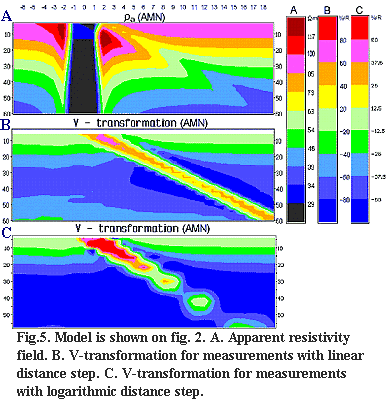 C-effect
- was found and described in 1991, firstly in modeling results and only
after that in field data. The main cause of that is in the difficulty of
finding C-effect on Rhoa pseudo-cross-section when all VES's
were measured with logarithmic distance step. On fig.2 and 5 are shown
results of modeling VES over two-layered structure with one NSI. (2a -
the model; 5a - Rhoa pseudo-cross-section for AMN array, 5b
- V-transformation; 2c - different VES curves for several variants of meeting
elements of array and NSI (fig.2b), 0 -
non-distorted and 1-4 - distorted by P or C-effect).
Some distortions of sounding curves are conformable (fig.2c,1-2), whereas
others are nonconformable (fig.2c,3-4). On apparent resistivity crosssection
distortions display as vertical and inclined strip zones (fig.5). When
moving current electrode hits the NSI, VES curve noticeably changes on
one or two distances due to abrupt change in current density in the cross-section.
C-effect
- was found and described in 1991, firstly in modeling results and only
after that in field data. The main cause of that is in the difficulty of
finding C-effect on Rhoa pseudo-cross-section when all VES's
were measured with logarithmic distance step. On fig.2 and 5 are shown
results of modeling VES over two-layered structure with one NSI. (2a -
the model; 5a - Rhoa pseudo-cross-section for AMN array, 5b
- V-transformation; 2c - different VES curves for several variants of meeting
elements of array and NSI (fig.2b), 0 -
non-distorted and 1-4 - distorted by P or C-effect).
Some distortions of sounding curves are conformable (fig.2c,1-2), whereas
others are nonconformable (fig.2c,3-4). On apparent resistivity crosssection
distortions display as vertical and inclined strip zones (fig.5). When
moving current electrode hits the NSI, VES curve noticeably changes on
one or two distances due to abrupt change in current density in the cross-section.
 C-effect
has several particularities, which do it more dangerous, than P-effect:
a) The form of VES curve and consequently visible layers number changes;
b) On profile VES data C-effect shows itself on Rhoa cross-section
as dipping layer (fig.5b), and in the case of logarithmic scale along AO
axis it seems to be bent layer. c) when standard sounding technology is
used (four electrodes Schlumberger array and logarithmic step in distance
growth), C-effect results from A and from B electrodes occasionally and
irregularly only at the moments when current electrodes exactly hit NSI.
In this case the main sign of C-effect - its form - disappears. Case C
on fig.4 shows V-transformation for AMN array
with logarithmic step in distance growth. C-effect in this case loose its
regularity. d) On Rhoa cross-section C-effect is not distinctly
visible due to great changes in Rhoa level with distances (fig.5a).
To find and recognize C-effect the special technology of field measurements
and results visualization is needed (V-transformation).
C-effect
has several particularities, which do it more dangerous, than P-effect:
a) The form of VES curve and consequently visible layers number changes;
b) On profile VES data C-effect shows itself on Rhoa cross-section
as dipping layer (fig.5b), and in the case of logarithmic scale along AO
axis it seems to be bent layer. c) when standard sounding technology is
used (four electrodes Schlumberger array and logarithmic step in distance
growth), C-effect results from A and from B electrodes occasionally and
irregularly only at the moments when current electrodes exactly hit NSI.
In this case the main sign of C-effect - its form - disappears. Case C
on fig.4 shows V-transformation for AMN array
with logarithmic step in distance growth. C-effect in this case loose its
regularity. d) On Rhoa cross-section C-effect is not distinctly
visible due to great changes in Rhoa level with distances (fig.5a).
To find and recognize C-effect the special technology of field measurements
and results visualization is needed (V-transformation).